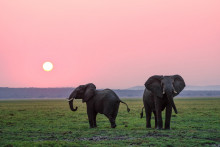The paper ‘Human footprint and protected areas shape elephant range across Africa’ was published this month in Current Biology. For two decades, the research team has tracked 229 African elephants using GPS collars, investigating what areas elephants use and how this relates to human activities.
What the animals need
‘This paper has been a long time coming. The initial discussion for this study happened when I was a postdoc in Oxford in 2007,’ says Jelle Ferwerda. At the time he was conducting research into spatial economics and remote sensing of elephants. ‘To conserve the species, you need to know how the animals behave. Back then, I was hired by the University of Oxford to work with Save the Elephants (STE) to help pinpoint how animals use the landscape and what they need in order to survive.’
‘The initial idea for the study was to find out what space the elephants use and need,’ continues Ferwerda. ‘This is also important in order to limit the interaction with people. Elephants are hunted by poachers, they might be killed by farmers if they interfere with their crops, but there might also be roads built directly in their migration paths. Knowing where they are helps us reduce conflict between elephants and humans.’
Staying away from people
The collected data now shows that elephants only use 17% of areas that are potentially suitable for them. ‘Much larger space in Africa could be used by the species, but human presence and actions prevent them from doing so. In fact, the study shows that 62% of the African continent is potential elephant habitat. We also saw that the animals mostly use conservation areas, meaning areas where there are no people. Elephants have learnt to avoid humans.’
‘We should focus on how to live with nature, rather than determining where nature lives’
Is there anything that can be done to improve this situation? ‘If we look at Kenya, we see that organizations such as STE have an important role in public outreach. Together with the elephants and bees projects elephants and farmers are learning to co-live. Long term, much larger conservation areas, space only dedicated to nature and animals, are key. At the same time, the population density keeps increasing, and so this option doesn’t seem realistic,’ answers Ferwerda. ‘However, these studies can help us see which areas are the most useful for conservations, which ones are used by elephants the most. In the long run, I believe we should focus on how to live with nature, rather than determining where nature lives. And that’s where spatial planning can play a role.’







